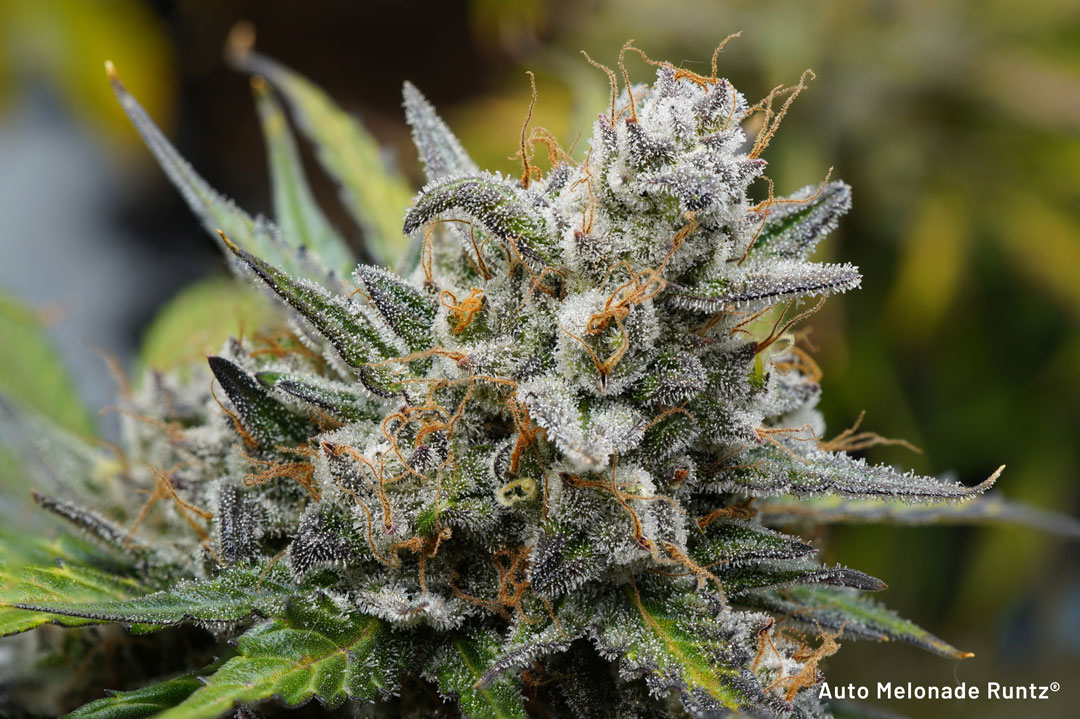What is Farnesene and what are the effects of this terpene?

Farnesene is a little-known and elusive cannabis terpene. Farnesene produces a fruity aroma, with green apple peel being perhaps the most familiar scent. Others report a woody citrus aroma with hints of tropical fruit. Farnesene actually refers to 6 nearly-identical chemical compounds. Several plants, including the potato family, are known to produce Farnesene products which are thought to act as an insect repellant.
| Related: |
| Everything you need to know about cannabis terpenes |
Farnesene terpene structure

Farnesene itself has some structural similarities to other terpenes. It has 15 carbon atoms in a branched chain and boils at 124 Celsius. Farnesene terpenes are a subgroup of the cannabis terpene family known as sesquiterpenes. The general structure is similar to other terpenes, though the precise structural arrangement and number of carbon atoms varies from one terpene to the next.
Farnesene terpene properties
Farnesene is thought to have anti-inflammatory and antimicrobial properties and calming and sedative effects in humans. Farnesene works together with other cannabis terpenes, to have various effects on the body. One of the more interesting plant-insect interactions is that one of the Farnesene compounds known as (E)-β-Farnesene is an alarm pheromone in most aphid species. This means that aphids exposed to (E)-β-Farnesene become agitated and may disperse from their host plant. The vapour of (E)-β-Farnesene is also toxic to whiteflies at sufficiently high concentrations. Perhaps one of the reasons cannabis evolved the ability to produce Farnesene was to help deter insect predation.
Farnesene aroma

The unmistakably fresh and invigorating scent of green apple peel is perhaps the most recognisable quality of Farnesene. To some, Farnesene also produces a tropical/citrus/woody aroma. The presence of Farnesene in a cannabis strain doesn’t mean you can necessarily expect an intense apple-sauce flavour to your buds. That’s because Farnesene tends to be a minor cannabinoid, the aroma of which can be masked/altered by more abundant cannabis terpenes (such as myrcene, limonene, caryophyllene etc).
Farnesene taste
As with the aroma, the main taste is that of crunchy green apples. But it should be noted that Farnesene is usually present in trace/small quantities and the taste is usually affected by the presence of larger concentrations of the more common (major) terpenes. As most cannabis connoisseurs will already be aware, once a cocktail of terpenes is present the final taste is determined by the compositional ratio of the various terpenes.
Farnesene occurs naturally in a variety of plants, yet all these plants have differing taste/aroma due to the complicated array other terpenes present. This is illustrated by the following plants all of which produce Farnesene: ginger, sandalwood, hops, grapefruit, turmeric, chamomile, cedarwood, oranges, apples etc.
Farnesene effects
.jpg)
As a minor terpene, not all strains will contain Farnesene. And those that do may only have small levels present. So far, and after hundreds of recent lab tests, no cannabis strain has yet been found where Farnesene is the dominant/main cannabis terpene. But where this terpene is seen the strains often have a calming/soothing effect. Chamomile is one herb which is naturally high in Farnesene and the relaxing effects of chamomile may be, in part, due to the presence of Farnesene. Some studies have shown that Farnesene (and other terpenes) can act also as a physical relaxant for muscle tissue - useful to know for medical cannabis patients.
Farnesene applications and benefits
Although a relatively little-known cannabis terpene, Farnesene has already attracted some interest from the medical community. Here are some of the more interesting findings:
• Farnesene and tooth decay. Cariogenic bacteria are responsible for tooth decay. A 2012 study suggests that Farnesene inhibits bacterial growth and may reduce the incidence of tooth decay.
• Anti-inflammatory & anti microbial properties of Farnesene. A Farnesene-rich plant oil (derived from Valeriana jatamansi has been shown to offer antimicrobial potential against Bacillus pumilus, Staphylococcus aureus, Staphylococcus epidermidis, Escherichia coli, Pseudomonas aeruginosa and Candida albicans. Swiss Albino mice were treated with a Farnesene rich topical cream, the anti-inflammatory properties were found to be on a par with traditional pharmaceuticals.
• Farnesene improves gut health by inhibiting harmful bacteria. A joint research program with Washington State University and Marathwada University (Nanded, India) has shown that Farnesene (and other plant extracts) had ‘significant effects’ in controlling the damaging pathogenic yeast known as c.albicans. One other useful feature of Farnesene is the ability to rupture the cell membrane of harmful bacteria.
• Farnesene may assist anxiety reduction. Cannabis is, for many, a highly effective way to dissolve stress and anxiety. Add in a rich terpene sauce and you have a relaxing and soothing, tasty and aromatic experience. One study involved inhalation of a Farnesene-rich essential oil. The study showed a reduction in anxiety/depression and improved memory function.
Cannabis strains high in Farnesene

Up until 2024, only trace levels of Farnesene were present in some of Dutch Passion’s cannabis seed varieties. The release of Auto Melonade Runtz marks a major milestone in that regard, as this is the first cannabis strain in which Dutch Passion geneticists have concentrated Farnesene, placing this terpene in the top 5-6 of the total terpene composition.
Beta-Farnesene and homegrown cannabis
If you’re growing cannabis seeds at home you are in the best position to be able to select your strains according to your needs and grow them in the best conditions you can offer. Often the serious home grower can produce far higher quality buds than those which can be bought locally. Our guide to increasing the terpene levels in your harvest is useful reading for anyone keen to increase Farnesene levels in their cannabis harvests.




























